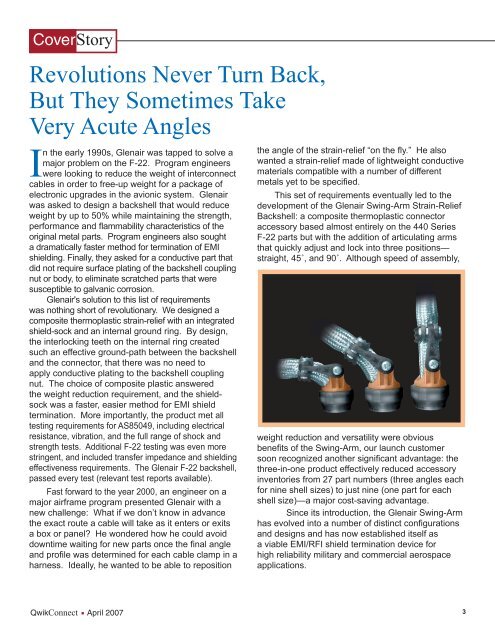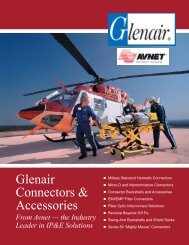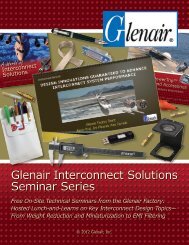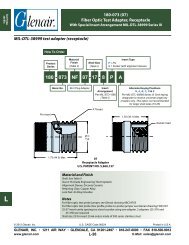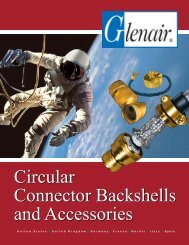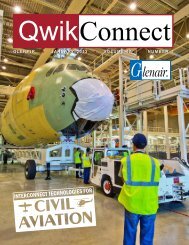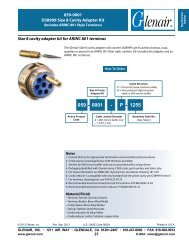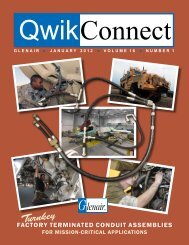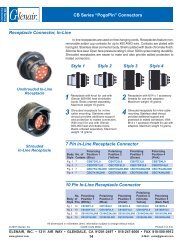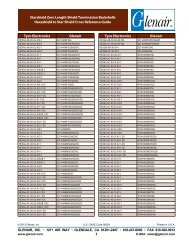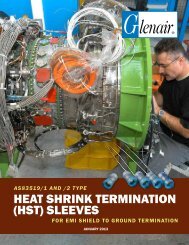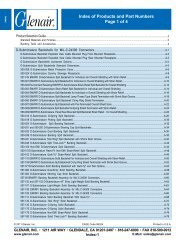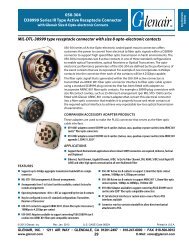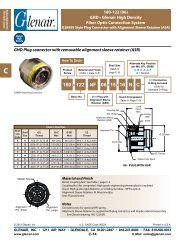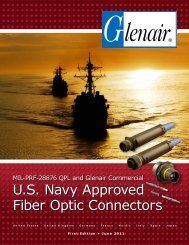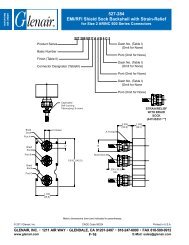April 2007 - Glenair, Inc.
April 2007 - Glenair, Inc.
April 2007 - Glenair, Inc.
You also want an ePaper? Increase the reach of your titles
YUMPU automatically turns print PDFs into web optimized ePapers that Google loves.
CoverStory<br />
Revolutions Never Turn Back,<br />
But They Sometimes Take<br />
Very Acute Angles<br />
I<br />
n the early 1990s, <strong>Glenair</strong> was tapped to solve a<br />
major problem on the F-22. Program engineers<br />
were looking to reduce the weight of interconnect<br />
cables in order to free-up weight for a package of<br />
electronic upgrades in the avionic system. <strong>Glenair</strong><br />
was asked to design a backshell that would reduce<br />
weight by up to 50% while maintaining the strength,<br />
performance and flammability characteristics of the<br />
original metal parts. Program engineers also sought<br />
a dramatically faster method for termination of EMI<br />
shielding. Finally, they asked for a conductive part that<br />
did not require surface plating of the backshell coupling<br />
nut or body, to eliminate scratched parts that were<br />
susceptible to galvanic corrosion.<br />
<strong>Glenair</strong>'s solution to this list of requirements<br />
was nothing short of revolutionary. We designed a<br />
composite thermoplastic strain-relief with an integrated<br />
shield-sock and an internal ground ring. By design,<br />
the interlocking teeth on the internal ring created<br />
such an effective ground-path between the backshell<br />
and the connector, that there was no need to<br />
apply conductive plating to the backshell coupling<br />
nut. The choice of composite plastic answered<br />
the weight reduction requirement, and the shieldsock<br />
was a faster, easier method for EMI shield<br />
termination. More importantly, the product met all<br />
testing requirements for AS85049, including electrical<br />
resistance, vibration, and the full range of shock and<br />
strength tests. Additional F-22 testing was even more<br />
stringent, and included transfer impedance and shielding<br />
effectiveness requirements. The <strong>Glenair</strong> F-22 backshell,<br />
passed every test (relevant test reports available).<br />
Fast forward to the year 2000, an engineer on a<br />
major airframe program presented <strong>Glenair</strong> with a<br />
new challenge: What if we don’t know in advance<br />
the exact route a cable will take as it enters or exits<br />
a box or panel He wondered how he could avoid<br />
downtime waiting for new parts once the fi nal angle<br />
and profi le was determined for each cable clamp in a<br />
harness. Ideally, he wanted to be able to reposition<br />
the angle of the strain-relief “on the fl y.” He also<br />
wanted a strain-relief made of lightweight conductive<br />
materials compatible with a number of different<br />
metals yet to be specifi ed.<br />
This set of requirements eventually led to the<br />
development of the <strong>Glenair</strong> Swing-Arm Strain-Relief<br />
Backshell: a composite thermoplastic connector<br />
accessory based almost entirely on the 440 Series<br />
F-22 parts but with the addition of articulating arms<br />
that quickly adjust and lock into three positions—<br />
straight, 45˚, and 90˚. Although speed of assembly,<br />
weight reduction and versatility were obvious<br />
benefi ts of the Swing-Arm, our launch customer<br />
soon recognized another signifi cant advantage: the<br />
three-in-one product effectively reduced accessory<br />
inventories from 27 part numbers (three angles each<br />
for nine shell sizes) to just nine (one part for each<br />
shell size)—a major cost-saving advantage.<br />
Since its introduction, the <strong>Glenair</strong> Swing-Arm<br />
has evolved into a number of distinct confi gurations<br />
and designs and has now established itself as<br />
a viable EMI/RFI shield termination device for<br />
high reliability military and commercial aerospace<br />
applications.<br />
QwikConnect · <strong>April</strong> <strong>2007</strong><br />
3


